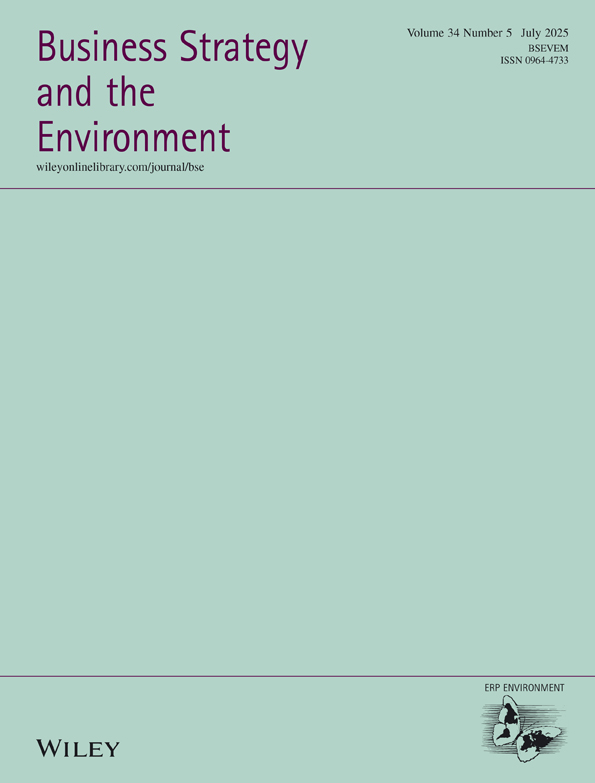Overcoming barriers to sustainability: an explanation of residential builders' reluctance to adopt clean technologies
Corresponding Author
Jonatan Pinkse
University of Amsterdam Business School, The Netherlands
University of Amsterdam Business School, Roetersstraat 11, 1018 WB Amsterdam, The NetherlandsSearch for more papers by this authorCorresponding Author
Jonatan Pinkse
University of Amsterdam Business School, The Netherlands
University of Amsterdam Business School, Roetersstraat 11, 1018 WB Amsterdam, The NetherlandsSearch for more papers by this authorAbstract
The construction industry has great opportunities to significantly reduce CO2 emissions by improving the energy efficiency of residential buildings. However, in this industry, diffusion of cost-effective clean technologies has been notoriously slow and below potential. This paper sheds light on factors that explain why construction companies have been reluctant to adopt energy-efficient technologies. It questions why some companies have intensified their investments in clean technologies, while others are lagging behind. Based on a multiple case study of four Dutch building contractors, the paper shows that contractors that actively gather information and build internal technical capacity are keener on adopting energy-efficient technologies. Findings also reveal that it will be a major challenge for the construction industry to communicate the advantages of clean technologies to (potential) home buyers and create market demand. Copyright © 2008 John Wiley & Sons, Ltd and ERP Environment.
REFERENCES
- Aragón-Correa JA, Sharma S. 2003. A contingent resource-based view of proactive corporate environmental strategy. Academy of Management Review 28(1): 71–88.
- Beerepoot M, Beerepoot N. 2007. Government regulation as an impetus for innovation: evidence from energy performance regulation in the Dutch residential building sector. Energy Policy 35: 4812–4825. DOI: 10.1016/j.enpol.2007.04.015
- Bozdogan K, Deyst J, Hoult D, Lucas M. 1998. Architectural innovation in product development through early supplier integration. R&D Management 28(3): 163–173. DOI: 10.1111/1467-9310.00093
- Central Bureau for Statistics (CBS). 2007. Duurzame Energie in Nederland 2006. CBS: Voorburg/Heerlen.
-
del Río González P. 2005. Analysing the factors influencing clean technology adoption: a study of the Spanish pulp and paper industry. Business Strategy and the Environment 14(1): 20–37. DOI: 10.1002/bse.426
10.1002/bse.426 Google Scholar
- EC. 2003. Directive 2002/91/EC of the European Parliament and of the Council of 16 December 2002 on the Energy Performance of Buildings. Official Journal of the European Communities L 1/65.
- EC. 2006. Environmental Impact of Products – Analysis of the Life Cycle Environmental Impacts Related to the Final Consumption of the EU-25. EC–IPTS–ESTO: Brussels.
- Eisenhardt KM, Martin JA. 2000. Dynamic capabilities: what are they? Strategic Management Journal 21(10/11): 1105–1121. DOI: 10.1002/1097-0266(200010/11)21:10/113.0.CO;2-E
- Frooman J. 1999. Stakeholder influence strategies. Academy of Management Review 24(2): 191–205.
- Helfat CE. 1997. Know-how and asset complementarity and dynamic capability accumulation: the case of R&D. Strategic Management Journal 18(5): 339–360. DOI: 10.1002/(SICI)1097-0266(199705)18:53.0.CO;2-7
- Henderson RM, Clark KB. 1990. Architectural innovation: the reconfiguration of existing product technologies and the failure of established firms. Administrative Science Quarterly 35(1): 9–30.
- Howarth RB, Andersson B. 1993. Market barriers to energy efficiency. Energy Economics 15(4): 262–272. DOI: 10.1016/0140-9883(93)90016-K
- Jaffe AB, Stavins RN. 1994. The energy-efficiency gap – what does it mean? Energy Policy 22(10): 804–810. DOI: 10.1016/0301-4215(94)90138-4
- Jawahar IM, McLaughlin GL. 2001. Toward a descriptive stakeholder theory: an organizational life cycle approach. Academy of Management Review 26(3): 397–414.
-
Jeswani HK, Wehrmeyer W, Mulugetta Y. 2008. How warm is the corporate response to climate change? Evidence from Pakistan and the UK. Business Strategy and the Environment 17(1): 46–60. DOI: 10.1002/bse.569
10.1002/bse.569 Google Scholar
- Kolk A, Levy D. 2004. Multinationals and global climate change: issue for the automotive and oil industries. In Multinationals, Environment and Global Competition, SM Lundan (ed.). Elsevier: Amsterdam. DOI: 10.1016/S1064-4857(03)09008–9
-
Kolk A, Pinkse J. 2006. Stakeholder mismanagement and corporate social responsibility crises. European Management Journal 24(1): 59–72. DOI: 10.1016/j.emj.2005.12.008
10.1016/j.emj.2005.12.008 Google Scholar
- Könnöla T, Unruh GC. 2007. Really changing the course: the limitations of environmental management systems for innovation. Business Strategy and the Environment 16(8): 525–537. DOI: 10.1002/bse.487
-
Madsen H, Ulhøi JP. 2001. Integrating environmental and stakeholder management. Business Strategy and the Environment 10(2): 77–88. DOI: 10.1002/bse.279
10.1002/bse.279 Google Scholar
- McKinsey Global Institute (MGI). 2007. Curbing Global Energy Demand Growth: the Energy Productivity Opportunity. MGI: San Francisco.
- Miles MB, Huberman AM. 1994. Qualitative Data Analysis – an Expanded Sourcebook. Sage: Thousand Oaks, CA.
- Miozzo M, Dewick P. 2002. Building competitive advantage: innovation and corporate governance in European construction. Research Policy 31(6): 989–1008. DOI: 10.1016/S0048-7333(01)00173-1
- Pernick R, Wilder C. 2007. The Clean Tech Revolution: the Next Big Growth and Investment Opportunity. HarperCollins: New York.
-
Pries F, Janszen F. 1995. Innovation in the construction industry: the dominant role of the environment. Construction Management and Economics 13(1): 43–51.
10.1080/01446199500000006 Google Scholar
-
Revell A, Blackburn R. 2007. The business case for sustainability? An examination of small firms in the UK's construction and restaurant sectors. Business Strategy and the Environment 16(6): 404–420. DOI: 10.1002/bse.499
10.1002/bse.499 Google Scholar
- Russo MV. 2008. Explaining the impact of ISO 14001 on emission performance: a dynamic capabilities perspective on process and learning. Business Strategy and the Environment in press. DOI: 10.1002/bse.587
- Shama A. 1983. Energy conservation in US buildings – solving the high potential/low adoption paradox from a behavioural perspective. Energy Policy 11(2): 148–167. DOI: 10.1016/0301-4215(83)90027-7
- Sharma S, Vredenburg H. 1998. Proactive corporate environmental strategy and the development of competitively valuable organizational capabilities. Strategic Management Journal 19(8): 729–753. DOI: 10.1002/(SICI)1097-0266(199808)19:83.0.CO;2-4
- Teece DJ, Pisano G, Shuen A. 1997. Dynamic capabilities and strategic management. Strategic Management Journal 18(7): 509–533. DOI: 10.1002/(SICI)1097-0266(199708)18:73.0.CO;2-Z
- Toole TM. 1998. Uncertainty and home builders' adoption of technological innovations. Journal of Construction Engineering and Management 124(4): 323–332.
-
Tushman ML, Nadler DA. 1978. Information processing as an integrating concept in organizational design. Academy of Management Review 3(3): 613–624.
10.2307/257550 Google Scholar
- Unruh GC. 2000. Understanding carbon lock-in. Energy Policy 28(12): 817–830. DOI: 10.1016/S0301-4215(00)00070-7
- Zahra SA, George G. 2002. Absorptive capacity: a review, reconceptualization, and extension. Academy of Management Review 27(2): 185–203.




